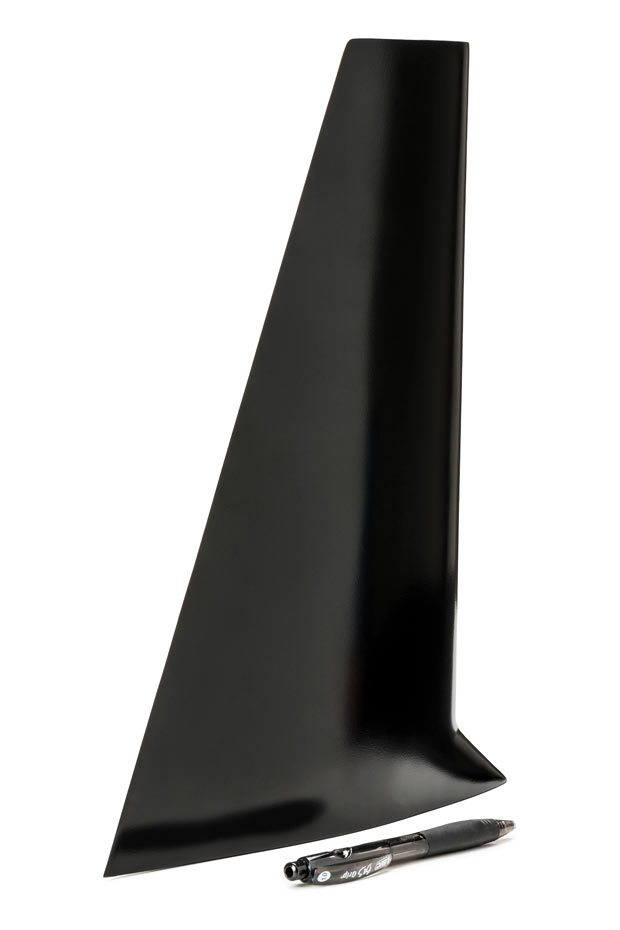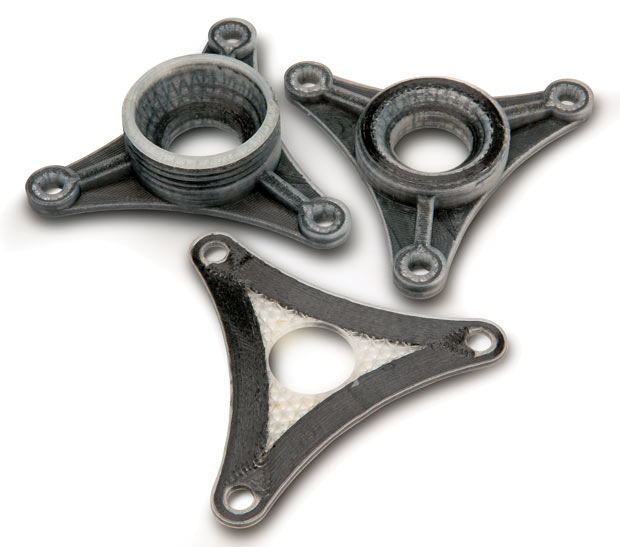
Sample high-strength parts, including ball-joints, 3D printed from continuous carbon fiber reinforced nylon on the new industrial Mark Two system from MarkForged. Image courtesy of MarkForged.
Latest News
June 1, 2016
Just a few years ago, any article focused on 3D printing with composite materials was a fairly short piece. Now, the same subject could possibly fill a magazine, given the recent wave of materials and systems developments aimed at 3D printing stronger and lighter parts.
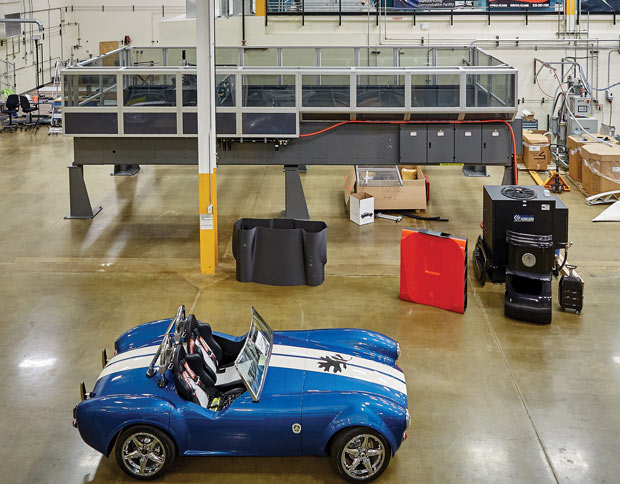 Finished Shelby Cobra car plus as-built parts, 3D-printed from composite filament on the Cincinnati Inc. Big Area Additive Manufacturing (BAAM) system; design by Local Motors. Image courtesy of Cincinnati Inc.
Finished Shelby Cobra car plus as-built parts, 3D-printed from composite filament on the Cincinnati Inc. Big Area Additive Manufacturing (BAAM) system; design by Local Motors. Image courtesy of Cincinnati Inc.Parts made from carbon fiber reinforced plastics (CFRPs) have been used for decades because of their high strength-to-weight ratios; polymers such as nylon and fillers such as fiberglass are also widely used. However, traditional composite-manufacturing processes often involve hand lay-ups and require post-processing such as autoclaving and vacuum-molding. Such tasks can demand higher skills and greater costs than working with standard plastics or metals. Because designers are always looking for stronger materials to use with 3D printing/additive manufacturing (AM) systems, it is no wonder that this material concept is getting increased attention. DE takes a look at AM composite handling systems and materials now available or coming soon, as well as at efforts in supporting areas.
Hardware for 3D Printing with Composites
The A2V2 by Italian manufacturer 3ntr is a fused filament fabrication (FFF) system whose wide operating temperature range (up to 410°C) allows it to run several composite filament types including nylon/carbon and PA66 nylon/glass. With a print volume of 24.4x13.7x19.2 in. it is targeted to industrial production. Plural Additive Manufacturing carries the system in the U.S.
Cincinnati Incorporated (CI) has made headlines in recent years for its Big Area Additive Manufacturing (BAAM) extrusion equipment, which has been run mostly with carbon fiber reinforced ABS (acrylonitrile butadiene styrene) plastic composite materials. The company worked with Local Motors to 3D print both the Strati car and the Shelby Cobra reproduction, a kickoff to a planned line of community-designed, locally produced vehicles. According to Matt Garbarino, marketing manager for CI, Local Motors now owns three BAAM systems, including one at Local Motors’ headquarters in Chandler, AZ, and one being installed at its National Harbor, MD, Microfactory. Garbarino says the rate of improvements for the system, materials and programming software is very fast right now; another one of their customers, SABIC IP, is devoting its machine entirely to material development. SABIC’s THERMOCOMP chopped carbon fiber compound was used to build the Strati vehicle.
Also operating in the FFF additive manufacturing space, but addressing the need for “medium-sized” parts is Cosine Additive. Founded in 2013, the company even terms its AM1 system a MAAM — a take-off on CI’s BAAM — offering a build volume of 43x33x35 in. Andrew McCalip, CTO, stated that his company is specifically pursuing the molding and forming market: The AM1 system is designed to produce composite-based tooling to produce economical first articles. “We’ve found huge value in compounding mostly carbon fiber (in polycarbonates); it vastly increases the stiffness of the mold. We’re able to use less material and still meet the heat deflection requirements and the pressure requirements of these forming processes,” he explains.
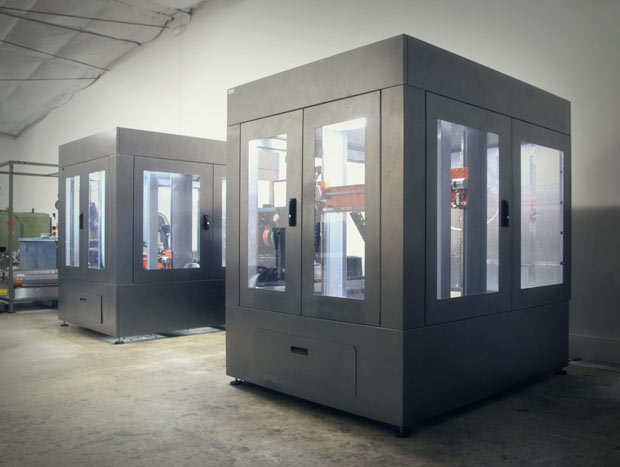 Medium Area Additive Manufacturing (MAAM) filament-based system from Cosine Additive is pictured. The company is particularly targeting the molding and forming market with this system that runs high-fiber-content composite materials. Image courtesy of Cosine Additive.
Medium Area Additive Manufacturing (MAAM) filament-based system from Cosine Additive is pictured. The company is particularly targeting the molding and forming market with this system that runs high-fiber-content composite materials. Image courtesy of Cosine Additive.McCalip says ultimately their forms are compared to aluminum molds; with a high enough fiber content, composite molds achieve similar compressive yield and stiffness. The company is agnostic to what flows through the AM1 nozzles, but has worked with glass-filled nylon and is looking into using higher-temperature polyphenylsulfide (PPS) with higher carbon fiber content to be a drop-in for Al 6061.
Having made a big splash at last year’s RAPID show, Impossible Objects continues to develop its composite-based additive manufacturing (CBAM) technology based on a unique layering process. A proprietary, low-viscosity fluid is jetted in a CAD-directed pattern onto thin sheets of carbon fiber, Kevlar, fiberglass or other fiber material. A thermoplastic powder (e.g., nylon PA12, high density polyethylene, PEEK) is deposited and adheres just to the wetted areas. The complete set of layers is compressed and heated, melting the thermoplastic and creating a fully dense part once excess material is removed. Functioning currently as a service bureau, Impossible Objects is working on a beta program for production machines, touting the process’ speed for creating strong, complex AM parts.
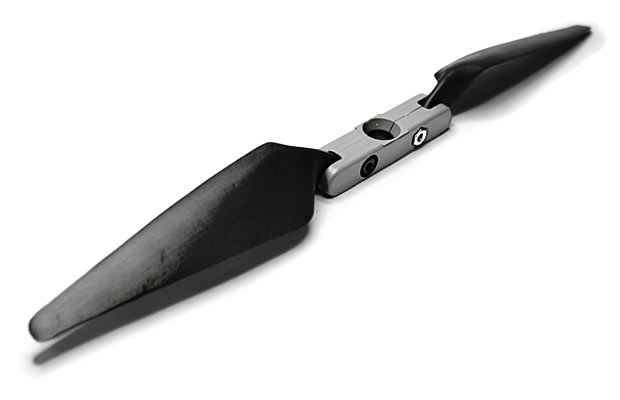 Carbon fiber composite folding drone propellers, with finished surfaces, built on an Impossible Objects composite-based additive manufacturing (CBAM) system. Image courtesy of Impossible Objects.
Carbon fiber composite folding drone propellers, with finished surfaces, built on an Impossible Objects composite-based additive manufacturing (CBAM) system. Image courtesy of Impossible Objects.This past March, MarkForged, developer of the first continuous composite fiber filament AM systems, introduced the Mark Two, replacing the Mark One. This improved model can lay carbon fiber (alongside nylon) in volumes 15 times smaller than the Mark One, producing smaller parts that are even stronger and bigger parts that are stiffer near edges and corners, all at a 40% faster speed. The Standard system prints with two choices of composite — fiberglass and carbon fiber; the Professional model can also use continuous Kevlar fibers; and the Enterprise version adds the option of new high strength, high-temperature (HSHT) fiberglass. The latter is the first in a series of new materials that will be coming out this year.
Greg Mark, founder and president of MarkForged, says that the Mark Two features a new print head, electronics, software and stainless-steel drive mechanism, optional telemetry monitoring and other improvements aimed at keeping customers up and running when using these challenging, abrasive composite materials. “Everything in [the Mark] Two is hardened compared to the One, and in the Enterprise kit, everything [in the print head area] is hardened more than the rest,” he notes.
 Sample high-strength parts, including ball-joints, 3D printed from continuous carbon fiber reinforced nylon on the new industrial Mark Two system from MarkForged. Image courtesy of MarkForged.
Sample high-strength parts, including ball-joints, 3D printed from continuous carbon fiber reinforced nylon on the new industrial Mark Two system from MarkForged. Image courtesy of MarkForged.Composite AM Materials
Several companies have decades of experience developing composite AM materials for laser sintering (LS) AM systems such as those from 3D Systems and EOS. Advanced Laser Materials (ALM), a wholly owned subsidiary of EOS, continues to develop laser-sintering plastics including versions of PA11 nylon (filled with carbon or glass fiber) and PA12 nylon (filled with aluminum, glass spheres or fibers of carbon, glass, or minerals). CRP Technology is well known for its high-performance Windform powders; the product line includes polyamide-based materials that offer high strength, high stiffness, waterproof/water-resistant performance and/or flexibility. And for stereolithography (SLA) systems, look to DSM Somos’ PerFORM, a ceramic plastic resin that produces stiff, off-white, high-temperature-resistant parts ideal for injection tooling and wind-tunnel testing applications.
Back in the FFF realm, Arevo Labs of Santa Clara, CA, has not only developed a family of proprietary composite thermoplastic filaments but has a number of related projects underway. Currently available are Katevo (high-strength PEEK/carbon fiber), Quantevo (PAEK/carbon fiber or carbon nanotube) and Xanevo (PARA/glass). The company sees interest, for example, in the electronics industry because test-jigs made from Quantevo with carbon nanotubes provide electrostatic-discharge (ESD) protection, and in the medical field because parts made from Xanevo, due to its stiffness, can serve as economical, single-use replacements for metal surgical guides.
“We are developing continuous-fiber-based composites that will be announced later this year. These materials, in conjunction with our software, will enable 3D printing large aerospace and industrial parts with comparable strength to metal but at one third the weight,” says Hemant Bheda, president of Arevo Labs. Last year the company also started offering a turn-key 6-axis robotic 3D printing platform; the ultimate goal is to define a build process that continuously re-orients a part to avoid the need for support material.
Almost two years ago Avante Technology announced its first product in a line of engineering grade AM materials, FilaOne GREEN Advanced Composite filament, designed for use in cost-saving desktop 3D printers. The company says this proprietary material is stronger and more resilient than ABS and PLA (polylactic acid), safer and easier to print than ABS or nylon (with no harmful out-gassing), and is not affected by moisture or humidity. FilaOne GREEN prints at 210 C and will also degrade in landfill.
The company has now introduced FilaOne GRAY, a tough yet flexible filament that is also hydrophobic, prints at 220°C and has been shown to be highly chemical resistant. Avante Technology president Bob Zollo says: “One of the unique properties of this carbon-nanotube-reinforced material is its combination of high flexural strength with high resilience; it recovers with minimal crazing or cracking under heavy loads.” He adds, “The industry needs hundreds of new materials and formulations. We’re trying to develop a line of materials that produce ‘real’ parts on affordable systems.” The company also markets print-bed adhesion sheets optimized for each of its filaments and Emendo STL file repair/validation software.
Graphene 3D Lab has seen a very positive response to its composite materials for 3D printing. An impressive application of its graphene filament is capacitive-touch interactive devices for Ideum smart-tables, such as used in the guided wine-tasting experience created for JCB Tasting Salon in Yountville, CA; this employs 3D-printed capacitive bases on the wine glasses to trigger changing information displays. A more engineering-related example is a 3D-printed joystick or stylus unit that allows users to interact with 3D CAD files on Ideum displays. Conductive circuitry and EMI/RF shielding are additional applications.
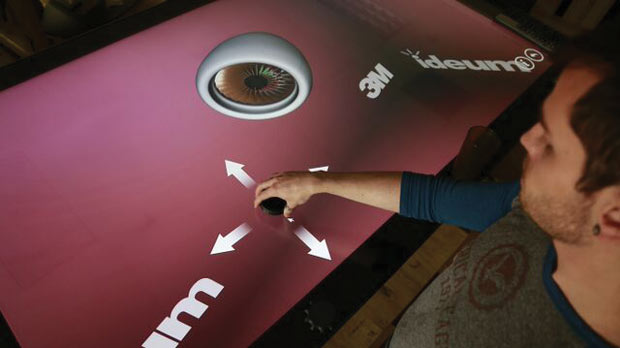 A 3D-printed joystick, made from Graphene 3D Lab’s conductive filament, provides a capacitive connection to an interactive smart-table display. Image courtesy of Graphene 3D Lab.
A 3D-printed joystick, made from Graphene 3D Lab’s conductive filament, provides a capacitive connection to an interactive smart-table display. Image courtesy of Graphene 3D Lab.The company recently announced a PLA/iron filament that is magnetically conductive, suited to making switches, sensors and actuators. In addition, Graphene 3D Lab has several divisions working on a variety of advanced technology projects targeted to next-generation 3D printers. “We make advanced materials for 3D printing and outside of 3D printing. To keep the excitement and challenge, we want to make not only static objects, but get to where we can 3D print electronics, light sources, batteries, and so on. We are not limited to filaments; future 3D printers will combine different techniques,” says Elena Stolyarov, co-CEO and president of Graphene 3D Lab.
In a Class of Their Own
Of course, Stratasys offers what can be considered composite material options, with its Connex3 PolyJet Digital Materials technology creating parts with varying properties in real time during a print run. But if you think you’re aware of all possible approaches to 3D printing in general and using composites in particular, you may have to think again.
Consider the medical implant company Amedica of Salt Lake City, UT. In 2008, it received 510(k) clearance from the FDA for the first spinal fusion device made from silicon nitride. The company is now in the first phase of working with this proprietary ceramic composite in slurry form, using a robotic deposition (3D fabrication) process to create other implants (e.g., spine, knee, hip). Mike Houston, vice president of Commercialization for Amedica, says the project’s phase-two goal is to generate parts with greater resolution, enabling them to 3D print finer products such as dental implants. “Our third phase is to improve the process to make porous silicon-nitride implants, and not just for orthopedic applications. To be able to 3D print and customize a resorbable scaffold for reconstructive surgery that is load-bearing, bone-friendly and anti-bacterial — we’re excited about what the future holds in that realm,” he says.
Aeroprobe, based in Christiansburg, VA, is progressing from a quiet nine years of R&D into the commercialization phase of its additive friction-stir deposition technology. Company CEO Nanci Hardwick explains that this process, developed in general about 30 years ago, produces results similar to those of other solid-state processes. “Any time you’re not melting metals,” she says, “it has benefits. People who develop metal powders know that rapid solidification offers higher strength; if you melt it, you lose that strength.”
The Aeroprobe system supports building really large parts at a high deposition rate, feeding from two material hoppers. The company has worked with a wide range of base materials such as magnesium, aluminum, steel and nickel alloys, plus solid or powder reinforcement materials such as silicon carbide, tungsten, tantalum and niobium. Hardwick points out that this is an open system, and her company will work with customers to optimize parts either for strength or ductility. Quoting is now underway.
Lastly, two other composites research programs worth following involve 3D printing a UV-cured resin containing ultrasonically aligned glass microfibers (Advanced Composites Centre for Innovation and Science, University of Bristol) and development of design guidelines for AM with composites (pd|z Product Development Group, ETH Zurich).
For More Info
Subscribe to our FREE magazine, FREE email newsletters or both!
Latest News
About the Author
Pamela Waterman worked as Digital Engineering’s contributing editor for two decades. Contact her via .(JavaScript must be enabled to view this email address).
Follow DE






